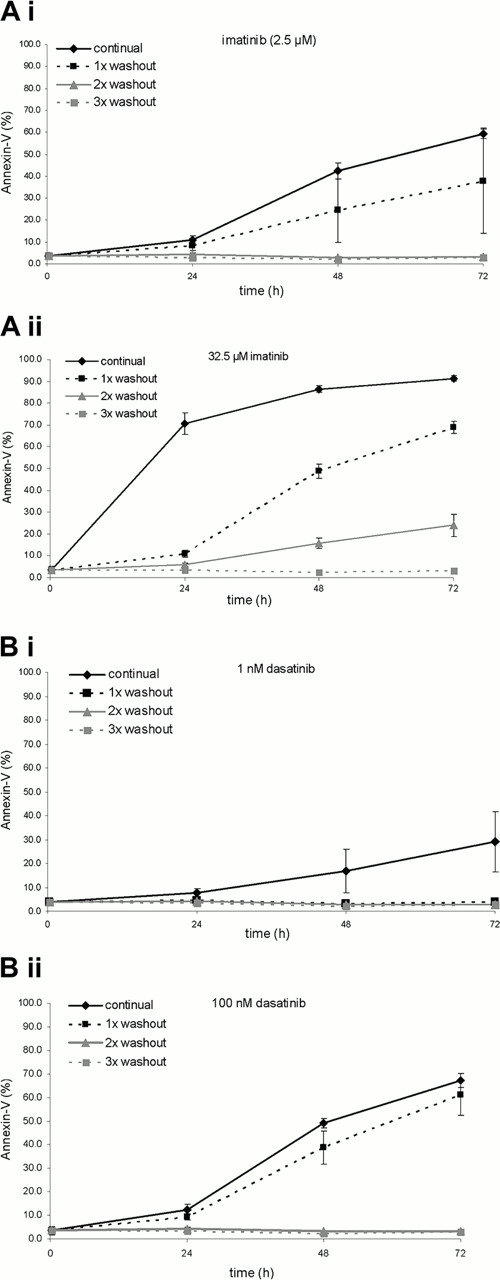Abstract
Abstract 1668
Chronic myeloid leukemia (CML) is a clonal myeloproliferative disorder of hemopoietic stem cells. The constitutively active tyrosine kinase BCR-ABL causes defects in the proliferation and differentiation of blood cells. CML is currently treated with tyrosine kinase specific inhibitors (TKIs), such as imatinib, nilotinib, and dasatinib. Transient, potent BCR-ABL inhibition with TKIs was demonstrated to commit CML cells to apoptosis irreversibly (Shah et al., Cancer Cell, 2008; Snead et al., Blood., 2009; Hiwase et al., Leukemia, 2009). This mechanism would explain the clinical efficacy of once-daily dasatinib treatment, despite the rapid clearance of the drug from the plasma. The restoration of BCR-ABL activity after TKI washout was demonstrated using phosphorylated CRKL (p-CRKL) protein as a surrogate marker.
Our in vitro data challenges this model. We suggest that apoptosis observed in the BCR-ABL-positive cell line K562 and progenitor cells from chronic phase CML patients with transient dasatinib treatment is instead caused by residual kinase inhibition that persists as a consequence of intracellular drug retention. Relatively high intracellular concentrations of imatinib and dasatinib residues were measured in transiently treated K562 cells using a nanoscale liquid chromatography in-line-coupled with ion trap mass spectrometry (nanoLC-MS/MS system) (Table 1). Western blot analysis confirmed that TKI washout restored p-CRKL. However, STAT5 and ERK, two other important BCR-ABL downstream pathways, remained inhibited in K562 cells. These data suggest that p-CRKL, may not have the capacity to detect this residual TKI. Subsequent flow cytometric analysis confirmed that the residual kinase inhibition is not detectable by p-CRKL assay. To prove apoptosis is caused by residual TKI, we rescued apoptosis by performing additional washout steps in K562 cells treated with various concentrations of TKIs and measured Annexin-V expression (Figure 1). The apoptosis was completely reversible in all samples.
We conclude that the reason for the equivalent efficacy of the once-daily and twice-daily TKI treatments is the most likely the intracellular retention of a low TKI concentration rather than the induction of irreversible apoptosis under a high-dose pulse treatment. Our data suggest that BCR-ABL is inhibited by residual TKI that cannot be detected by p-CRKL assay. The residual TKI was directly measured intracellularly, and it is possible to remove it by subsequent washout steps, which gradually restore apoptosis. These findings confirm that continuous target inhibition is required for the optimal efficacy of kinase inhibitors.
Intracellular concentrations of imatinib and dasatinib in K562 cells. Cells were incubated with the indicated TKI either continuously or for 0.3 hours followed by drug washout and further culture in TKI-free medium. Aliquots were lysed at defined time points and analyzed by nanoLC-MS/MS (n=3)
| Hours after initiation of exposure | 0.3 | 2 | 6 | 12 | 24 |
| 2.5 ìM imatinib continuous (ìM) | 76 ± 2 | 225 ± 3 | |||
| 32.5 ìM imatinib continuous (ìM) | 4000 ± 200 | 1140 ± 60 | |||
| 32.5 ìM imatinib pulse (ìM) | 3000 ± 100 | 66 ± 3 | 70.0 ± 0.2 | 60 ± 1 | 40 ± 2 |
| 1 nM dasatinib continuous (nM) | 120 ± 20 | 200 ± 4 | |||
| 100 nM dasatinib continuous (nM) | 4400 ± 100 | 3190 ± 80 | |||
| 100 nM dasatinib pulse (nM) | 4600 ± 100 | 350 ± 20 | 250 ± 10 | 290 ± 10 | 257 ± 8 |
| Hours after initiation of exposure | 0.3 | 2 | 6 | 12 | 24 |
| 2.5 ìM imatinib continuous (ìM) | 76 ± 2 | 225 ± 3 | |||
| 32.5 ìM imatinib continuous (ìM) | 4000 ± 200 | 1140 ± 60 | |||
| 32.5 ìM imatinib pulse (ìM) | 3000 ± 100 | 66 ± 3 | 70.0 ± 0.2 | 60 ± 1 | 40 ± 2 |
| 1 nM dasatinib continuous (nM) | 120 ± 20 | 200 ± 4 | |||
| 100 nM dasatinib continuous (nM) | 4400 ± 100 | 3190 ± 80 | |||
| 100 nM dasatinib pulse (nM) | 4600 ± 100 | 350 ± 20 | 250 ± 10 | 290 ± 10 | 257 ± 8 |
Effect of multiple TKI washouts on early apoptosis in K562 cells. Cells were treated in vitro with imatinib (A) or dasatinib (B) at a low-dose (i; 2.5 μM or 1 nM, respectively) or high-dose (ii; 32.5 μM or 100 nM, respectively). Cells were cultured under four conditions, as indicated: 1) continuous TKI; 2) TKI washout after 0.3 hours (1× washout); 3) TKI washout after 0.3 hours + second washout after 1 hour (2× washout) and 4) TKI washout after 0.3 hours + second washout after 1 hour + third washout after 2 hours (3× washout). Each TKI washout was performed three times with 10 ml of PBS. Cell aliquots were harvested after 0.3, 24, 48, and 72 hours, and Annexin-V was used to measure apoptosis by flow cytometry (n=3).
Effect of multiple TKI washouts on early apoptosis in K562 cells. Cells were treated in vitro with imatinib (A) or dasatinib (B) at a low-dose (i; 2.5 μM or 1 nM, respectively) or high-dose (ii; 32.5 μM or 100 nM, respectively). Cells were cultured under four conditions, as indicated: 1) continuous TKI; 2) TKI washout after 0.3 hours (1× washout); 3) TKI washout after 0.3 hours + second washout after 1 hour (2× washout) and 4) TKI washout after 0.3 hours + second washout after 1 hour + third washout after 2 hours (3× washout). Each TKI washout was performed three times with 10 ml of PBS. Cell aliquots were harvested after 0.3, 24, 48, and 72 hours, and Annexin-V was used to measure apoptosis by flow cytometry (n=3).
No relevant conflicts of interest to declare.
Author notes
Asterisk with author names denotes non-ASH members.


This feature is available to Subscribers Only
Sign In or Create an Account Close Modal